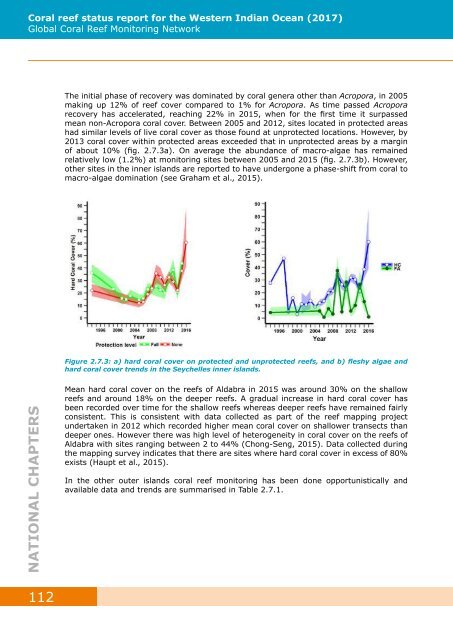GCRMN_COI_2017-Western Indian Ocean Reef Status
GCRMN Western Indian Ocean Coral Reef Status report for 2017. Produced by the Indian Ocean Commission and CORDIO East Africa
GCRMN Western Indian Ocean Coral Reef Status report for 2017. Produced by the Indian Ocean Commission and CORDIO East Africa
Create successful ePaper yourself
Turn your PDF publications into a flip-book with our unique Google optimized e-Paper software.
Coral reef status report for the <strong>Western</strong> <strong>Indian</strong> <strong>Ocean</strong> (<strong>2017</strong>)<br />
Global Coral <strong>Reef</strong> Monitoring Network<br />
The initial phase of recovery was dominated by coral genera other than Acropora, in 2005<br />
making up 12% of reef cover compared to 1% for Acropora. As time passed Acropora<br />
recovery has accelerated, reaching 22% in 2015, when for the first time it surpassed<br />
mean non-Acropora coral cover. Between 2005 and 2012, sites located in protected areas<br />
had similar levels of live coral cover as those found at unprotected locations. However, by<br />
2013 coral cover within protected areas exceeded that in unprotected areas by a margin<br />
of about 10% (fig. 2.7.3a). On average the abundance of macro-algae has remained<br />
relatively low (1.2%) at monitoring sites between 2005 and 2015 (fig. 2.7.3b). However,<br />
other sites in the inner islands are reported to have undergone a phase-shift from coral to<br />
macro-algae domination (see Graham et al., 2015).<br />
Figure 2.7.3: a) hard coral cover on protected and unprotected reefs, and b) fleshy algae and<br />
hard coral cover trends in the Seychelles inner islands.<br />
NATIONAL CHAPTERS<br />
Mean hard coral cover on the reefs of Aldabra in 2015 was around 30% on the shallow<br />
reefs and around 18% on the deeper reefs. A gradual increase in hard coral cover has<br />
been recorded over time for the shallow reefs whereas deeper reefs have remained fairly<br />
consistent. This is consistent with data collected as part of the reef mapping project<br />
undertaken in 2012 which recorded higher mean coral cover on shallower transects than<br />
deeper ones. However there was high level of heterogeneity in coral cover on the reefs of<br />
Aldabra with sites ranging between 2 to 44% (Chong-Seng, 2015). Data collected during<br />
the mapping survey indicates that there are sites where hard coral cover in excess of 80%<br />
exists (Haupt et al., 2015).<br />
In the other outer islands coral reef monitoring has been done opportunistically and<br />
available data and trends are summarised in Table 2.7.1.<br />
112


















